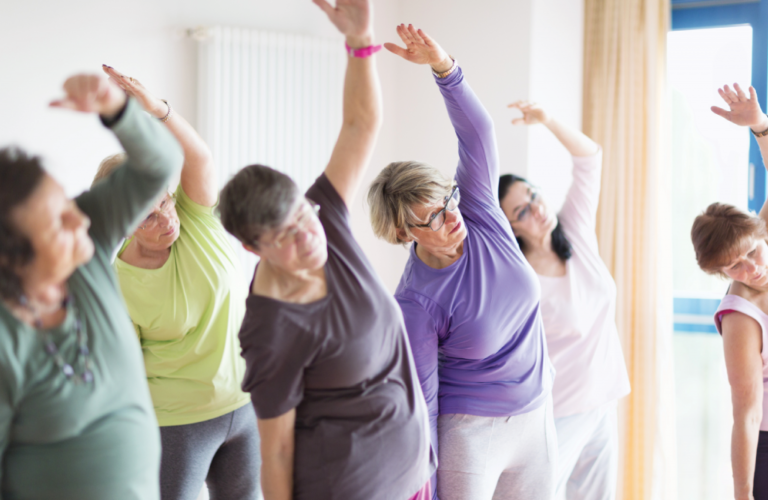Maintain Balance and Reduce the risk of Falling

Why should I exercise?
Physical exercise has innumerous benefits for the body. It was not very long ago that daily life included liberal amounts of exercise. For instance, people walked to get where they were going, they swung axes to chop wood to burn for warmth, and they had to hunt and gather their food. Nowadays we have many conveniences that have significantly reduced the amount of physical activity required to live day to day. However, the body never lost it’s need to be exercised.
People often look at exercise as strictly a tool for weight loss. While it is important to maintain a healthy bodyweight for general health, exercise does much more than help with the number on the scale. When we exercise, we are supporting our muscle mass. Muscle gives us strength, not just to lift heavy objects, but to stand up from a sitting position, to maintain our balance and reduce the risk of falling, to open jars and bottles, and to lift heavy bags of groceries without hurting ourselves. Muscle burns a lot of calories, even at rest (calories are how we measure energy contained in the foods we eat, as well as the energy our bodies burn to live). Muscle loss leads to impaired immune system function. Weak leg muscles are associated with higher risk of heart problems. As you can see, there are many reasons to strive to support your muscle mass.
Exercise also supports bone density and strength, healthy blood vessel function, good blood sugar control, emotional well-being, and brain health. Research has actually found that frequent exercisers have brains that look like the brains of young people on imaging studies.
Getting Started
The first thing someone should do when starting a new exercise habit, is to discuss it with their doctor. Once okayed by your doctor, it is important to start off gently and not overdo it. Exercise tolerance must be built over time. Injury can result from being too aggressive too quickly. Walking is often a great way to start out. You may find you have to limit the amount of time you exercise at first to less than the amount of time we’re recommending. That’s completely okay! Your exercise capacity will increase over time as long as you remain consistent.
What to strive for:
- For moderate intensity exercise: 150 minutes per day, or about 22 minutes per day
- Examples of moderate intensity exercise:
- Brisk walking (at least 2.5 miles per hour)
- Water aerobics
- Dancing
- Gardening
- Tennis doubles
- Slow biking
- Lifting very light weights with rest in between sets (weight that you can lift more than 20 times in a row – aka repetitions)
- Examples of moderate intensity exercise:
- For vigorous intensity exercise: 75 minutes per week, or about 11 minutes per day
- Examples of vigorous intensity exercise:
- Running
- Hiking uphill with a heavy backpack
- Swimming laps
- Aerobics
- Tennis singles
- Fast cycling (faster than 10 miles per hour)
- Jumping rope
- Lifting heavier weights with rest in between sets (weights that you can left less than 20 times in a row) or lifting light weights with little to no rest
- Examples of vigorous intensity exercise:
IMPORTANT:
Remember, before you consider vigorous exercise, you must first be able to tolerate moderate exercise very well. Even then it is not without risk. It’s important to be mindful of heart rate (and blood sugar levels if you are diabetic) during intense exercise. Even if your moderate intensity exercise capacity is good, if you want to try vigorous intensity exercise, talk to your doctor first, and start with just a little bit at a time to gauge your body’s reaction to the intensity, and to acclimate your body to it.
Sources:
American Heart Association Recommendations for Physical Activity in Adults and Kids. https://www.heart.org/en/healthy-living/fitness/fitness-basics/aha-recs-for-physical-activity-in-adults.
Larson EB, Wang L, Bowen JD, McCormick WC, Teri L, Crane P, Kukull W. Exercise is associated with reduced risk for incident dementia among persons 65 years of age and older. Ann Intern Med. 2006 Jan 17;144(2):73-81. doi: 10.7326/0003-4819-144-2-200601170-00004. PMID: 16418406.
Willey JZ, Gardener H, Caunca MR, Moon YP, Dong C, Cheung YK, Sacco RL, Elkind MS, Wright CB. Low leisure-time physical activity associates with cognitive decline: The Northern Manhattan Study.
Neurology. 2016 May 17;86(20):1897-903. doi: 10.1212/WNL.0000000000002582. Epub 2016 Mar 23.
PMID: 27009261; PMCID: PMC4873686.


